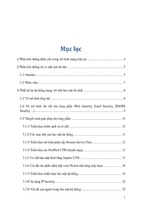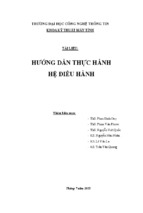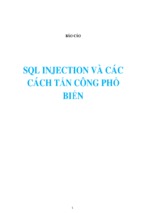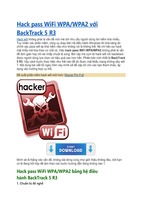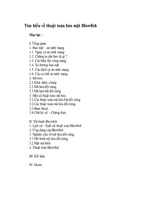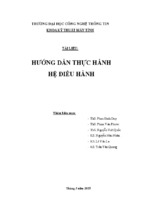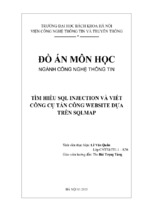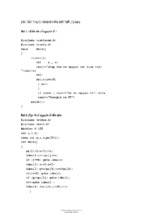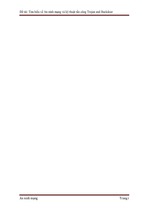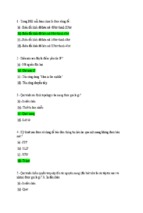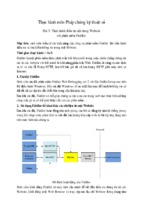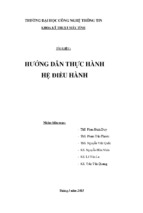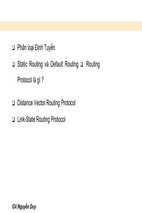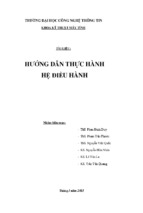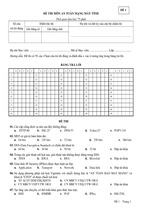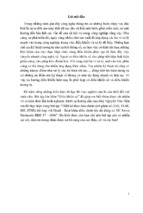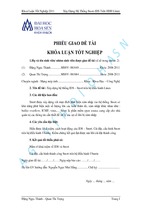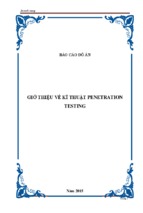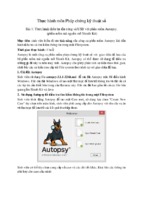INFORMATION RESOURCE GUIDE
Computer, Internet and Network Systems Security
An Introduction to Security
i
Security Manual
Compiled By:
S.K.PARMAR, Cst
N.Cowichan Duncan RCMP Det
6060 Canada Ave., Duncan, BC
250-748-5522
[email protected]
This publication is for informational purposes only. In no way should this publication by interpreted as offering
legal or accounting advice. If legal or other professional advice is needed it is encouraged that you seek it from
the appropriate source. All product & company names mentioned in this manual are the [registered] trademarks
of their respective owners. The mention of a product or company does not in itself constitute an endorsement.
The articles, documents, publications, presentations, and white papers referenced and used to compile this
manual are copyright protected by the original authors. Please give credit where it is due and obtain
permission to use these. All material contained has been used with permission from the original author(s) or
representing agent/organization.
ii
TableofContent
1.0 INTRODUCTION........................................................................................................................................................... 2
1.1 BASIC INTERNET TECHNICAL DETAILS ........................................................................................................................ 2
1.1.1 TCP/IP : Transmission Control Protocol/Internet Protocol ............................................................................ 2
1.1.2 UDP:User Datagram Protocol............................................................................................................................ 2
1.1.3 Internet Addressing ............................................................................................................................................. 3
1.1.4 Types of Connections and Connectors ............................................................................................................ 3
1.1.5 Routing .................................................................................................................................................................. 6
1.2 Internet Applications and Protocols...................................................................................................................... 6
1.2.1 ARCHIE..................................................................................................................................................................................6
1.2.2 DNS — Domain Name System...........................................................................................................................................7
1.2.3 E-mail — Electronic Mail......................................................................................................................................................7
1.2.4 SMTP — Simple Mail Transport Protocol..........................................................................................................................7
1.2.5 PEM — Privacy Enhanced Mail..........................................................................................................................................8
1.2.6 Entrust and Entrust-Lite .......................................................................................................................................................8
1.2.7 PGP — Pretty Good Privacy ...............................................................................................................................................8
1.2.8 RIPEM — Riordan's Internet Privacy-Enhanced Mail......................................................................................................9
1.2.9 MIME — Multipurpose Internet Mail Extensions ..............................................................................................................9
1.3 File Systems ............................................................................................................................................................ 9
1.3.1 AFS — Andrew File system ................................................................................................................................................9
1.3.2 NFS — Network File System ..............................................................................................................................................9
1.3.3 FTP — File Transfer Protocol ...........................................................................................................................................10
1.3.4 GOPHER..............................................................................................................................................................................10
1.3.5 ICMP — Internet Control Message Protocol...................................................................................................................10
1.3.6 LPD — Line Printer Daemon.............................................................................................................................................11
1.3.7 NNTP — Network News Transfer Protocol .....................................................................................................................11
1.3.8 News Readers.....................................................................................................................................................................11
1.3.9 NIS — Network Information Services ..............................................................................................................................11
1.3.10 RPC — Remote Procedure Call .....................................................................................................................................12
1.3.11 R-utils (rlogin, rcp, rsh).....................................................................................................................................................12
1.3.12 SNMP — Simple Network Management Protocol........................................................................................................12
1.3.13 TELNET .............................................................................................................................................................................12
1.3.14 TFTP ? Trivial File Transfer Protocol.............................................................................................................................12
1.3.15 Motif...................................................................................................................................................................................13
1.3.16 Openwindows....................................................................................................................................................................13
1.3.17 Winsock..............................................................................................................................................................................13
1.3.18 Windows — X11 ...............................................................................................................................................................13
1.3.19 WAIS — Wide Area Information Servers ......................................................................................................................13
1.3.20 WWW — World Wide Web .............................................................................................................................................13
1.3.21 HTTP — HyperText Transfer Protocol ..........................................................................................................................13
2.0 SECURITY ................................................................................................................................................................... 16
2.1 SECURITY POLICY ...................................................................................................................................................... 16
2.1.0 What is a Security Policy and Why Have One? ............................................................................................ 16
2.1.1 Definition of a Security Policy .......................................................................................................................... 17
2.1.2 Purposes of a Security Policy .......................................................................................................................... 17
2.1.3 Who Should be Involved When Forming Policy?.......................................................................................... 17
2.1.4 What Makes a Good Security Policy? ............................................................................................................ 18
2.1.5 Keeping the Policy Flexible .............................................................................................................................. 19
2.2 THREATS..................................................................................................................................................................... 19
2.2.0 Unauthorized LAN Access ............................................................................................................................... 21
2.2.1 Inappropriate Access to LAN Resources ....................................................................................................... 21
2.2.2 Spoofing of LAN Traffic..................................................................................................................................... 23
2.2.3 Disruption of LAN Functions ............................................................................................................................ 24
iii
2.2.4 Common Threats ............................................................................................................................................... 24
2.2.4.0 Errors and Omissions .....................................................................................................................................................24
2.2.4.1 Fraud and Theft ...............................................................................................................................................................25
2.2.4.2 Disgruntled Employees...................................................................................................................................................25
2.2.4.3 Physical and Infrastructure.............................................................................................................................................25
2.2.4.4 Malicious Hackers ...........................................................................................................................................................26
2.2.4.5 Industrial Espionage........................................................................................................................................................26
2.2.4.6 Malicious Code ................................................................................................................................................................27
2.2.4.7 Malicious Software: Terms.............................................................................................................................................27
2.2.4.8 Foreign Government Espionage ...................................................................................................................................27
2.3 SECURITY SERVICES AND MECHANISMS INTRODUCTION.......................................................................................... 27
2.3.0 Identification and Authentication ..................................................................................................................... 28
2.3.1 Access Control ................................................................................................................................................... 30
2.3.2 Data and Message Confidentiality .................................................................................................................. 31
2.3.3 Data and Message Integrity ............................................................................................................................. 33
2.3.4 Non-repudiation ................................................................................................................................................. 34
2.3.5 Logging and Monitoring .................................................................................................................................... 34
2.4 ARCHITECTURE OBJECTIVES ..................................................................................................................................... 35
2.4.0 Separation of Services...................................................................................................................................... 35
2.4.0.1 Deny all/ Allow all ............................................................................................................................................................35
2.4.1 Protecting Services ........................................................................................................................................... 36
2.4.1.0 Name Servers (DNS and NIS(+))..................................................................................................................................36
2.4.1.1 Password/Key Servers (NIS(+) and KDC) ...................................................................................................................36
2.4.1.2 Authentication/Proxy Servers (SOCKS, FWTK)..........................................................................................................36
2.4.1.3 Electronic Mail..................................................................................................................................................................37
2.4.1.4 World Wide Web (WWW)...............................................................................................................................................37
2.4.1.5 File Transfer (FTP, TFTP) ..............................................................................................................................................37
2.4.1.6 NFS ...................................................................................................................................................................................38
2.4.2 Protecting the Protection .................................................................................................................................. 38
2.5 AUDITING .................................................................................................................................................................... 38
2.5.1 What to Collect................................................................................................................................................... 38
2.5.2 Collection Process............................................................................................................................................. 38
2.5.3 Collection Load .................................................................................................................................................. 39
2.5.4 Handling and Preserving Audit Data............................................................................................................... 39
2.5.5 Legal Considerations ........................................................................................................................................ 40
2.5.6 Securing Backups.............................................................................................................................................. 40
2.6 INCIDENTS ................................................................................................................................................................... 40
2.6.0 Preparing and Planning for Incident Handling............................................................................................... 40
2.6.1 Notification and Points of Contact ................................................................................................................... 42
2.6.2 Law Enforcement and Investigative Agencies .............................................................................................. 42
2.6.3 Internal Communications.................................................................................................................................. 44
2.6.4 Public Relations - Press Releases.................................................................................................................. 44
2.6.5 Identifying an Incident ....................................................................................................................................... 45
2.6.5.1 Is it real? ...........................................................................................................................................................................45
2.6.6 Types and Scope of Incidents ......................................................................................................................... 46
2.6.7 Assessing the Damage and Extent................................................................................................................. 47
2.6.8 Handling an Incident ......................................................................................................................................... 47
2.6.9 Protecting Evidence and Activity Logs ........................................................................................................... 47
2.6.10 Containment ..................................................................................................................................................... 48
2.6.11 Eradication........................................................................................................................................................ 49
2.6.12 Recovery........................................................................................................................................................... 49
2.6.13 Follow-Up.......................................................................................................................................................... 49
2.6.14 Aftermath of an Incident ................................................................................................................................. 50
2.7 INTRUSION M ANAGEMENT SUMMARY ........................................................................................................................ 50
2.7.0 Avoidance ........................................................................................................................................................... 51
2.7.1 Assurance........................................................................................................................................................... 51
2.7.2 Detection............................................................................................................................................................. 52
iv
2.7.3 Investigation ....................................................................................................................................................... 52
2.8 MODEMS ..................................................................................................................................................................... 52
2.8.0 Modem Lines Must Be Managed..................................................................................................................... 52
2.8.1 Dial-in Users Must Be Authenticated.............................................................................................................. 53
2.8.2 Call-back Capability........................................................................................................................................... 53
2.8.3 All Logins Should Be Logged........................................................................................................................... 54
2.8.4 Choose Your Opening Banner Carefully........................................................................................................ 54
2.8.5 Dial-out Authentication...................................................................................................................................... 54
2.8.6 Make Your Modem Programming as "Bullet-proof" as Possible ................................................................ 54
2.9 DIAL UP SECURITY ISSUES ........................................................................................................................................ 55
2.9.0 Classes of Security Access Packaged for MODEM Access ....................................................................... 55
2.9.1 Tactical and Strategic Issues in Selecting a MODEM Connection Solution ............................................. 56
2.9.2 Background on User Access Methods and Security .................................................................................... 57
2.9.3 Session Tracking and User Accounting Issues............................................................................................. 60
2.9.4 Description of Proposed Solution to Dial-Up Problem ................................................................................. 61
2.9.5 Dissimilar Connection Protocols Support....................................................................................................... 63
2.9.6 Encryption/Decryption Facilities ...................................................................................................................... 63
2.9.7 Asynchronous Protocol Facilities .................................................................................................................... 63
2.9.8 Report Item Prioritization .................................................................................................................................. 64
2.9.9 User Profile “Learning” Facility ........................................................................................................................ 64
2.10 NETWORK SECURITY ............................................................................................................................................... 64
2.10.0 NIST Check List............................................................................................................................................... 65
2.10.0.0 Basic levels of network access:...................................................................................................................................65
2.10.1 Auditing the Process ....................................................................................................................................... 65
2.10.2 Evaluating your security policy ...................................................................................................................... 66
2.11 PC SECURITY ........................................................................................................................................................... 66
2.12 ACCESS .................................................................................................................................................................... 67
2.12.0 Physical Access............................................................................................................................................... 67
2.12.1 Walk-up Network Connections ...................................................................................................................... 68
2.13 RCMP GUIDE TO MINIMIZING COMPUTER THEFT................................................................................................... 68
2.13.0 Introduction....................................................................................................................................................... 68
2.13.1 Areas of Vulnerability and Safeguards......................................................................................................... 69
2.13.1.0 PERIMETER SECURITY .............................................................................................................................................69
2.13.1.1 SECURITY INSIDE THE FACILITY............................................................................................................................69
2.13.2 Physical Security Devices .............................................................................................................................. 70
2.13.2.0 Examples of Safeguards ..............................................................................................................................................70
2.13.3 Strategies to Minimize Computer Theft........................................................................................................ 73
2.13.3.0 APPOINTMENT OF SECURITY PERSONNEL........................................................................................................73
2.13.3.1 MASTER KEY SYSTEM...............................................................................................................................................73
2.13.3.2 TARGET HARDENING ................................................................................................................................................74
2.13.4 PERSONNEL RECOGNITION SYSTEM .................................................................................................... 74
2.13.4.0 Minimizing Vulnerabilities Through Personnel Recognition ....................................................................................74
2.13.5 SECURITY AWARENESS PROGRAM ....................................................................................................... 75
2.13.5.0 Policy Requirements .....................................................................................................................................................75
2.13.5.1 Security Awareness Safeguards .................................................................................................................................76
2.13.6 Conclusion........................................................................................................................................................ 76
2.14 PHYSICAL AND ENVIRONMENTAL SECURITY ........................................................................................................... 76
2.14.0 Physical Access Controls............................................................................................................................... 78
2.14.1 Fire Safety Factors.......................................................................................................................................... 79
2.14.2 Failure of Supporting Utilities......................................................................................................................... 80
2.14.3 Structural Collapse.......................................................................................................................................... 81
2.14.4 Plumbing Leaks ............................................................................................................................................... 81
2.14.5 Interception of Data......................................................................................................................................... 81
2.14.6 Mobile and Portable Systems........................................................................................................................ 82
2.14.7 Approach to Implementation.......................................................................................................................... 82
2.14.8 Interdependencies........................................................................................................................................... 83
v
2.14.9 Cost Considerations..................................................................................................................................... 84
2.15 CLASS C2: CONTROLLED ACCESS PROTECTION –AN INTRODUCTION ................................................................. 84
2.15.0 C2 Criteria Simplified ...................................................................................................................................... 84
2.15.1 The Red Book .................................................................................................................................................. 85
2.15.2 Summary .......................................................................................................................................................... 87
3.0 IDENTIFICATION AND AUTHENTICATION ......................................................................................................... 92
3.1 INTRODUCTION............................................................................................................................................................ 92
3.1.0 I&A Based on Something the User Knows ............................................................................................... 93
3.1.0.1 Passwords ........................................................................................................................................................................93
3.1.0.2 Cryptographic Keys.........................................................................................................................................................94
3.1.1 I&A Based on Something the User Possesses........................................................................................ 94
3.1.1.0 Memory Tokens ...............................................................................................................................................................94
3.1.1.1 Smart Tokens...................................................................................................................................................................95
3.1.2 I&A Based on Something the User Is......................................................................................................... 97
3.1.3 Implementing I&A Systems .............................................................................................................................. 98
3.1.3.0 Administration ..................................................................................................................................................................98
3.1.3.1 Maintaining Authentication .............................................................................................................................................98
3.1.3.2 Single Log-in ....................................................................................................................................................................99
3.1.3.3 Interdependencies...........................................................................................................................................................99
3.1.3.4 Cost Considerations........................................................................................................................................................99
3.1.4 Authentication .................................................................................................................................................. 100
3.1.4.0 One-Time passwords....................................................................................................................................................102
3.1.4.1 Kerberos .........................................................................................................................................................................102
3.1.4.2 Choosing and Protecting Secret Tokens and PINs ..................................................................................................102
3.1.4.3 Password Assurance ....................................................................................................................................................103
3.1.4.4 Confidentiality.................................................................................................................................................................104
3.1.4.5 Integrity ...........................................................................................................................................................................105
3.1.4.6 Authorization ..................................................................................................................................................................105
4.0 RISK ANALYSIS....................................................................................................................................................... 108
4.1 THE 7 PROCESSES ................................................................................................................................................... 108
4.1.0 Process 1 - Define the Scope and Boundary, and Methodology.............................................................. 108
4.1.0.1 Process 2 - Identify and Value Assets ...................................................................................................... 108
4.1.0.2 Process 3 - Identify Threats and Determine Likelihood.......................................................................... 110
4.1.0.3 Process 4 - Measure Risk........................................................................................................................... 111
4.1.0.4 Process 5 - Select Appropriate Safeguards ............................................................................................. 112
4.1.0.5 Process 6 - Implement And Test Safeguards .......................................................................................... 113
4.1.0.6 Process 7 - Accept Residual Risk.............................................................................................................. 114
4.2 RCMP GUIDE TO THREAT AND RISK ASSESSMENT FOR INFORMATION TECHNOLOGY........................................ 114
4.2.1 Introduction....................................................................................................................................................... 114
4.2.2 Process ............................................................................................................................................................. 114
4.2.2.0 Preparation .....................................................................................................................................................................115
4.2.2.1 Threat Assessment .......................................................................................................................................................118
4.2.2.2 Risk Assessment ...........................................................................................................................................................122
4.2.2.3 Recommendations ........................................................................................................................................................124
4.2.3 Updates ............................................................................................................................................................ 125
4.2.4 Advice and Guidance...................................................................................................................................... 126
4.2.5 Glossary of Terms ........................................................................................................................................... 127
5.0 FIREWALLS .............................................................................................................................................................. 130
5.1 INTRODUCTION.......................................................................................................................................................... 130
5.2 FIREWALL SECURITY AND CONCEPTS ..................................................................................................................... 131
5.2.0 Firewall Components ...................................................................................................................................... 131
5.2.0.0 Network Policy ...............................................................................................................................................................131
5.2.0.1 Service Access Policy...................................................................................................................................................131
5.2.0.2 Firewall Design Policy...................................................................................................................................................132
vi
5.2.1 Advanced Authentication................................................................................................................................ 133
5.3 PACKET FILTERING .................................................................................................................................................. 133
5.3.0 Which Protocols to Filter................................................................................................................................. 134
5.3.1 Problems with Packet Filtering Routers ....................................................................................................... 135
5.3.1.0 Application Gateways ...................................................................................................................................................136
5.3.1.1 Circuit-Level Gateways.................................................................................................................................................138
5.4 FIREWALL ARCHITECTURES..................................................................................................................................... 138
5.4.1 Multi-homed host ............................................................................................................................................. 138
5.4.2 Screened host .................................................................................................................................................. 139
5.4.3 Screened subnet.............................................................................................................................................. 139
5.5 TYPES OF FIREWALLS .............................................................................................................................................. 139
5.5.0 Packet Filtering Gateways.............................................................................................................................. 139
5.5.1 Application Gateways ..................................................................................................................................... 139
5.5.2 Hybrid or Complex Gateways ........................................................................................................................ 140
5.5.3 Firewall Issues ................................................................................................................................................. 141
5.5.3.0 Authentication ................................................................................................................................................................141
5.5.3.1 Routing Versus Forwarding..........................................................................................................................................141
5.5.3.2 Source Routing ..............................................................................................................................................................141
5.5.3.3 IP Spoofing .....................................................................................................................................................................142
5.5.3.4 Password Sniffing..........................................................................................................................................................142
5.5.3.5 DNS and Mail Resolution .............................................................................................................................................143
5.5.4 FIREWALL ADMINISTRATION ................................................................................................................................. 143
5.5.4.0 Qualification of the Firewall Administrator ................................................................................................ 144
5.5.4.1 Remote Firewall Administration ................................................................................................................. 144
5.5.4.2 User Accounts............................................................................................................................................... 145
5.5.4.3 Firewall Backup ............................................................................................................................................ 145
5.5.4.4 System Integrity............................................................................................................................................ 145
5.5.4.5 Documentation.............................................................................................................................................. 146
5.5.4.6 Physical Firewall Security ........................................................................................................................... 146
5.5.4.7 Firewall Incident Handling........................................................................................................................... 146
5.5.4.8 Restoration of Services ............................................................................................................................... 146
5.5.4.9 Upgrading the firewall .................................................................................................................................. 147
5.5.4.10 Logs and Audit Trails................................................................................................................................. 147
5.5.4.11 Revision/Update of Firewall Policy .......................................................................................................... 147
5.5.4.12 Example General Policies......................................................................................................................... 147
5.5.4.12.0 Low-Risk Environment Policies..............................................................................................................................147
5.5.4.12.1 Medium-Risk Environment Policies.......................................................................................................................148
5.5.4.12.2 High-Risk Environment Policies.............................................................................................................................149
5.5.4.13 Firewall Concerns: Management ............................................................................................................. 150
5.5.4.14 Service Policies Examples........................................................................................................................ 151
5.5.5 CLIENT AND SERVER SECURITY IN ENTERPRISE NETWORKS ............................................................................. 153
5.5.5.0 Historical Configuration of Dedicated Firewall Products ........................................................................ 153
5.5.5.1 Advantages and Disadvantages of Dedicated Firewall Systems.......................................................... 153
5.5.5.2 Are Dedicated Firewalls A Good Idea?..................................................................................................... 155
5.5.5.3 Layered Approach to Network Security - How To Do It.......................................................................... 155
5.5.5.4 Improving Network Security in Layers - From Inside to Outside ........................................................... 157
5.5.5.5 Operating Systems and Network Software - Implementing Client and Server Security.................... 158
5.5.5.6 Operating System Attacks From the Network Resource(s) - More Protocols Are The Norm - and
They Are Not Just IP ................................................................................................................................................. 159
5.5.5.7 Client Attacks - A New Threat .................................................................................................................... 159
5.5.5.8 Telecommuting Client Security Problems - Coming to Your Company Soon ..................................... 160
5.5.5.9 Compromising Network Traffic - On LANs and Cable Television It’s Easy ......................................... 162
5.5.5.10 Encryption is Not Enough - Firewall Services Are Needed As Well ................................................... 163
5.5.5.11 Multiprotocol Security Requirements are the Norm - Not the Exception. Even for Singular Protocol
Suites... ....................................................................................................................................................................... 163
5.5.5.12 Protecting Clients and Servers on Multiprotocol Networks - How to Do It ........................................ 164
vii
5.5.5.13 New Firewall Concepts - Firewalls with One Network Connection..................................................... 164
6.0 CRYPTOGRAPHY.................................................................................................................................................... 167
6.1 CRYPTOSYSTEMS ..................................................................................................................................................... 167
6.1.0 Key-Based Methodology ................................................................................................................................ 167
6.1.1 Symmetric (Private) Methodology ................................................................................................................. 169
6.1.2 Asymmetric (Public) Methodology................................................................................................................. 170
6.1.3 Key Distribution................................................................................................................................................ 172
6.1.4 Encryption Ciphers or Algorithms.................................................................................................................. 175
6.1.5 Symmetric Algorithms ..................................................................................................................................... 175
6.1.6 Asymmetric Algorithms ................................................................................................................................... 178
6.1.7 Hash Functions ................................................................................................................................................ 178
6.1.8 Authentication Mechanisms ........................................................................................................................... 179
6.1.9 Digital Signatures and Time Stamps ............................................................................................................ 180
7.0 MALICIOUS CODE .................................................................................................................................................. 182
7.1 WHAT IS A VIRUS? ................................................................................................................................................... 182
7.1.0 Boot vs File Viruses......................................................................................................................................... 183
7.1.1 Additional Virus Classifications...................................................................................................................... 183
7.2 THE NEW MACRO VIRUS THREAT............................................................................................................................ 183
7.2.0 Background ...................................................................................................................................................... 184
7.2.1 Macro Viruses: How They Work.................................................................................................................... 186
7.2.2 Detecting Macro Viruses ................................................................................................................................ 187
7.3 IS IT A VIRUS? .......................................................................................................................................................... 189
7.3.0 Worms ............................................................................................................................................................... 190
7.3.1 Trojan Horses................................................................................................................................................... 192
7.3.2 Logic Bombs..................................................................................................................................................... 192
7.3.3 Computer Viruses............................................................................................................................................ 193
7.3.4 Anti-Virus Technologies.................................................................................................................................. 194
7.4 ANTI-VIRUS POLICIES AND CONSIDERATIONS ........................................................................................................ 195
7.4.0 Basic "Safe Computing" Tips ......................................................................................................................... 196
7.4.1 Anti-Virus Implementation Questions ........................................................................................................... 197
7.4.2 More Virus Prevention Tips............................................................................................................................ 198
7.4.3 Evaluating Anti-Virus Vendors....................................................................................................................... 198
7.4.4 Primary Vendor Criteria .................................................................................................................................. 199
8.0 VIRTUAL PRIVATE NETWORKS: INTRODUCTION......................................................................................... 202
8.1 MAKING SENSE OF VIRTUAL PRIVATE NETWORKS ................................................................................................. 202
8.2 DEFINING THE DIFFERENT ASPECTS OF VIRTUAL PRIVATE NETWORKING ............................................................ 202
8.2.0 Intranet VPNs.................................................................................................................................................. 204
8.2.1 Remote Access VPNs..................................................................................................................................... 205
8.2.2 Extranet VPNs.................................................................................................................................................. 206
8.3 VPN ARCHITECTURE ............................................................................................................................................... 207
8.4 UNDERSTANDING VPN PROTOCOLS ....................................................................................................................... 208
8.4.0 SOCKS v5 ........................................................................................................................................................ 208
8.4.1 PPTP/L2TP....................................................................................................................................................... 209
8.4.2 IPSec ................................................................................................................................................................. 211
8.5 MATCHING THE RIGHT TECHNOLOGY TO THE GOAL ............................................................................................... 212
9.0 WINDOWS NT NETWORK SECURITY ................................................................................................................ 215
9.1 NT SECURITY MECHANISMS .................................................................................................................................... 215
9.2 NT TERMINOLOGY.................................................................................................................................................... 215
9.2.0 Objects in NT.................................................................................................................................................... 215
9.2.1 NT Server vs NT Workstation ........................................................................................................................ 216
9.2.2 Workgroups ...................................................................................................................................................... 216
viii
9.2.3 Domains ............................................................................................................................................................ 217
9.2.4 NT Registry....................................................................................................................................................... 217
9.2.5 C2 Security ....................................................................................................................................................... 218
9.3 NT SECURITY MODEL .............................................................................................................................................. 219
9.3.0 LSA: Local Security Authority ....................................................................................................................... 219
9.3.1 SAM: Security Account Manager .................................................................................................................. 220
9.3.2 SRM: Security Reference Monitor................................................................................................................. 220
9.4 NT LOGON................................................................................................................................................................ 221
9.4.0 NT Logon Process........................................................................................................................................... 222
9.5 DESIGNING THE NT ENVIRONMENT ........................................................................................................................ 222
9.5.0 Trusts and Domains ........................................................................................................................................ 223
9.6 GROUP M ANAGEMENT ............................................................................................................................................. 226
9.7 ACCESS CONTROL ................................................................................................................................................... 228
9.8 MANAGING NT FILE SYSTEMS ................................................................................................................................ 229
9.8.0 FAT File System .............................................................................................................................................. 229
9.8.1 NTFS File System ........................................................................................................................................... 230
9.9 OBJECT PERMISSIONS ............................................................................................................................................. 231
9.10 MONITORING SYSTEM ACTIVITIES ......................................................................................................................... 232
10.0 UNIX INCIDENT GUIDE ........................................................................................................................................ 234
10.1 DISPLAYING THE USERS LOGGED IN TO YOUR SYSTEM....................................................................................... 235
10.1.0 The “W” Command........................................................................................................................................ 235
10.1.1 The “finger” Command.................................................................................................................................. 236
10.1.2 The “who” Command .................................................................................................................................... 236
10.2 DISPLAYING ACTIVE PROCESSES.......................................................................................................................... 237
10.2.0 The “ps” Command ....................................................................................................................................... 237
10.2.1 The “crash” Command.................................................................................................................................. 238
10.3 FINDING THE FOOTPRINTS LEFT BY AN INTRUDER ................................................................................................ 238
10.3.0 The “last” Command ..................................................................................................................................... 239
10.3.1 The “lastcomm” Command .......................................................................................................................... 240
10.3.2 The /var/log/ syslog File................................................................................................................................ 241
10.3.3 The /var/adm/ messages File ...................................................................................................................... 242
10.3.4 The “netstat” Command................................................................................................................................ 243
10.4 DETECTING A SNIFFER ........................................................................................................................................... 243
10.4.1 The “ifconfig” Command............................................................................................................................... 244
10.5 FINDING FILES AND OTHER EVIDENCE LEFT BY AN INTRUDER ............................................................................ 244
10.6 EXAMINING SYSTEM LOGS .................................................................................................................................... 246
10.7 INSPECTING LOG FILES.......................................................................................................................................... 247
APPENDIX A : HOW MOST FIREWALLS ARE CONFIGURED ............................................................................ 251
APPENDIX B: BASIC COST FACTORS OF FIREWALL OWNERSHIP............................................................... 254
APPENDIX C: GLOSSARY OF FIREWALL RELATED TERMS............................................................................ 258
APPENDIX D: TOP 10 SECURITY THREATS........................................................................................................... 260
APPENDIX E: TYPES OF ATTACKS.......................................................................................................................... 262
APPENDIX F: TOP 10 SECURITY PRECAUTIONS................................................................................................. 265
APPENDIX G: VIRUS GLOSSARY ............................................................................................................................. 266
APPENDIX H: NETWORK TERMS GLOSSARY ...................................................................................................... 269
ix
x
Forward
This manual is an effort to assist law enforcement agencies and other
computer crime investigators by providing a resource guide compiled
from the vast pool of information on the Internet. This manual is not
intended to replace any formal training or education. This manual should
be used as a supplemental guide to reference too. It was not my
intention to compile this manual to provide a specific solution for
investigators. This was intended to provide a general overview, which
would assist in helping to developing a solution. This solution does not
have to be hardware or software based. Today policy-based protection
can also be incorporated into hardware and software systems.
I would like to thank all the authors, and organizations that have provided
me with materials to compile this manual. Some of the material
contained in this manual were a part of a larger document. It is strongly
recommended that if anyone has an interest in learning more about a
particular topic to find these documents on the Internet and read them.
A very special thanks to:
Dr. Bill Hancock
Network-1 Security Solutions, Inc.
(
[email protected])
who played an active role in the modeling of this manual.
Finally, please respect the copyrights of the original authors and
organizations and give them credit for their work.
Any questions or concerns can be directed to me c/o
RCMP Duncan Detachment
6060 Canada Ave., Duncan, BC
CANADA V9L 1V3
ATN: Cst. S.K.PARMAR
Telephone number 250-748-5522
Email:
[email protected]
SUNNY
1
1.0 Introduction
1.1 Basic Internet Technical Details
The Internet utilizes a set of networking protocols called TCP/IP. The applications
protocols that can be used with TCP/IP are described in a set of Internet
Engineering Task Force (IETF) RFCs (Request For Comment). These documents
describe the "standard" protocols and applications that have been developed to
support these protocols. Protocols provide a standard method for passing
messages. They define the message formats and how to handle error conditions.
Protocols are independent of vendor network hardware, this allows communication
between various networks with different hardware as long as they communicate
(understand) the same protocol. The following diagram provides a conceptual
layering diagram of the protocols.
1.1.1 TCP/IP : Transmission Control Protocol/Internet Protocol
TCP/IP is used to facilitate communication within a network of diverse hardware
technology. Information is broken into packets (usually in the range of 1-1500
characters long) to prevent monopolizing of the network. TCP is a transport level
protocol which allows a process on one computer to send data to a process on
another computer. It is a connection oriented
protocol which means that a path must be
established between the two computers. IP
defines the datagram, the format of the data
being transferred throughout the network and
performs connectionless delivery.
Connectionless delivery requires each
datagram to contain the source and destination
address and each datagram is processed
separately. TCP takes the information, and
breaks it into pieces called packets, numbers
the packets, and then sends them.
The receiving computer collects the packets,
takes out the data and puts them in the proper
Figure 1 : Conceptual Layering
order. If something is missing, the receiving
computer asks the sender to retransmit. The packet sent also contains a checksum
which is used to find errors that may have occurred during transmission. If the
receiving computer notices that an error has occurred when it computes and
compares the checksum, it throws that packet away and asks for a retransmission.
Once everything is received, the data is passed to the proper application (e.g. email).
1.1.2 UDP:User Datagram Protocol
The UDP has less overhead and is simpler than TCP. The concept is basically the
same except that UDP is not concerned about lost packets or keeping things in
order. It is used for short messages. If it does not receive a response, it just resends
the request. Thjs type of protocol transfer method is called a “connectionless
protocol.”
2
1.1.3 Internet Addressing
All computers on the Internet must have a distinct network address to be able to
efficiently communicate with each other. The addressing scheme used within the
Internet is a 32 - bit address segmented into a hierarchical structure. IP addresses
consist of four numbers, each less than 256 which are separated by periods.
(#.#.#.#) At the lowest level, computers communicate with each other using a
hardware address (on LANs, this is called the Medium Access Control or MAC
address). Computer users, however, deal with 2 higher levels of abstraction in order
to help visualize and remember computers within the network. The first level of
abstraction is the IP address of the computer (e.g. 131.136.196.2) and the second
level is the human readable form of this address (e.g. manitou.cse.dnd.ca). This
address scheme is currently under review as the address space is running out.
Address Resolution Protocol (ARP) can be used by the computer to resolve IP
addresses into the corresponding hardware addresses.
1.1.4 Types of Connections and Connectors
There are two types of computer hosts connected to the Internet: server hosts and
client hosts. The server host can be described as an “information provider”. This
type of host contains some type of resource or data which is available to other hosts
on the Internet. The second type of host connected to the Internet is the client host
which can be described as an “information retriever”. The client host will access
resources and data located on the server hosts, but usually will not provide any
resources back to the server host.
Both server and client host computers can be connected to the Internet by various
methods that offer different communication capabilities dependent on varied
communications surcharges.
Direct Internet Connections: A computer connected directly to the Internet via a
network interface will allow the user the highest internetwork functionality. Each
computer connected in this manner must also have a unique Internet (IP) address.
This type of connection is also the most expensive.
Serial Internet Connections: Another type of connection offering most
communications capabilities is a SLIP (Serial Line Internet Protocol) or PPP (Point
to Point Protocol) connection. These two connection schemes offer similar services:
full network and application capability over a serial (modem) line. Since this
connection offers full TCP/IP and ICMP functionality each computer configured in
this manner requires its own IP address. This type of connection is an on-demand
service, at slower speeds, that therefore reduces communications charges, however
all TCP/IP and Internet vulnerabilities remain when the connection is "live".
An important point for the network security investigator to remember is that most
dial-up TCP connections, either SLIP or PPP, assign the IP address to a connected
machine dynamically. This means that when a system dials-up to the Internet
Service Provider (ISP), the ISP assigns an IP address at that point. It also means
that the address for the dialer may change each and every time the system
connects. This can cause serious problems for the investigator when attempting to
trace access back through firewall and router logs for specific IP addresses. You will
need to work closely with the victim and the ISP to properly track which system was
assigned a particular IP address when the system connected to the ISP at a
particular point in time.
3
Host Access Connections: The most limited type of network access is available as a
user account on a host which is directly connected to the Internet. The user will then
use a terminal to access that host using a standard serial connection. This type of
connection is usually the most inexpensive form of access.
Sneaker-Net Connections: This type of connection is by far the most limiting, since
the computer has no electrical connection to the Internet at all. This type of
connection is the most secure because there is no direct access to the user's
computer by a hacker. If information and programs are required on the computer
they must be transferred from a networked computer to the user's computer via
magnetic media or manually.
All computers with direct, SLIP, and PPP connections must have their own IP
address, and their security administrators must be aware of the vulnerability
concerns associated with these connections. Communications channels work both
ways: a user having access to the Internet implies that the Internet also has access
to that user. Therefore, these computers must be protected and secured to ensure
the Internet has limited access. A terminal user calling using an Internet host has
fewer concerns since the host is where the Internet interface lies. In this situation
the host must take all necessary security precautions.
To connect the various sub-networks and pieces of the Internet together, hardware
equipment is required. The following are definitions of the various terms which are
use to describe this equipment.
Repeater
A repeater is a hardware device which is used to connect
two Local Area Segments that use the same physical level
protocol. The repeater will copy all bits from one network
segment to another network segment. This device will not
make any routing decisions at all, and will not modify the
packets. This device operates at layer 1 (Physical) of the
OSI Network Model. A repeater may also be used to
connect specific workstations in a physically local area to
each other. All units connected to a repeater “see” each
other’s traffic on the network. Repeaters are very often
used on networks like Ethernet/802.3 networks and very
commonly available at most computer stores at a low price.
Modem
A modem is a device which will convert between the digital
signal structures that computers require and the analog
voltage levels that are used by telephone services. The
term MODEM stands for MOdulator DEModulator. A
modem operates at level 1 (Physical) of the OSI Network
Model and therefore does not modify the data packets or
make any routing decisions. Modems are used to connect
two computers together over standard phone lines (usually
for on-demand services). Current MODEM speeds range
from 50 bits per second to over 56 thousand bits per
second (56kbps).
Bridge
A bridge is a device which is used to connect two Local
Area Networks that use the same LAN framing protocol
(such as Ethernet or token ring). The bridge acts as an
address filter by picking up packets from one LAN segment
and transferring them to another IF the bridge recognizes
that the packets need to travel from one LAN to the other. If
4
the communicating source system and destination system
are on the same side of the bridge, the bridge will not
forward the frame to the other side of the bridge.. The
bridge makes no modification to any packets it forwards,
and the bridge operates at layer 2 (data-link) of the OSI
Network Model.
Router
A router is a device that is used to connect two or more
LAN, MAN or WANsegments that may or may not use the
framing protocols. Since the router operates at level 3
(Network) of the OSI Network Model it is able to make
routing decisions based on the destination network address
(IP address for the Internet). Routers will sometimes have
filtering capability included. In this case a router might be
used as a packet filter to enhance security and/or reduce
traffic flow throughout the network that does not need to
traverse all locations on the network (described below).
Some very large routers at larger network sites can
interconnect dozens of different types of network framing
formats.
Gateway
A gateway is a device which will interconnect two network
segments which utilize different communications
architectures. Gateways typically function on a programtype by program-type (application) basis.The gateway maps
(or translates) data from one application to another
application and as such operates at level 7 (Application) of
the OSI Network Model.
Packet filter
Packet filtering is a capability usually added to routers, but
can be implemented in host or firewall systems as well.
Packet filtering applies a set of filters (or rules of traversal)
to all packets entering or leaving the filtering mechanism
that enable the router to decide whether the packet should
be forwarded or disregarded. For instance, security
configurations may add address filters for certain ranges of
addresses to keep traffic from roaming all over a network or
to keep undesireable addresses from accessing resources
that are restricted in access.
Firewall
A firewall is a description of a system (one or more pieces
of hardware) that acts as a barrier between two or more
network segments. A firewall can be used to provide a
barrier between an internal network and the Internet. A
firewall can be considered the technical implementation of a
security policy. The firewall upholds the security policy of a
network when connecting that network to a second network
which has a less stringent security policy.
Cyberwall
A cyberwall is similar in scope to a firewall, but instead of
offering perimeter defense filtering between two or more
networks, cyberwalls are typically installed on desktop and
server systems on the inside network at a corporate site.
Cyberwalls provide a defensive barrier to attacks on
mission critical systems on internal networks and help
“harden” the operating system environment from a network
5
attack. Some cyberwalls also include intrusion detection
software to allow the system to detect an attack of specific
types in progress and effect some levels of defense against
them.
Readers are cautioned that these terms are not always used in a consistent manner
in publications which can cause confusion or misconceptions.
1.1.5 Routing
There are two types of routing used by the Internet: source routing and dynamic
routing. The Internet is a very robust networking system. The network routers will
automatically (dynamically) send out messages to other routers broadcasting routes
to known domains and addresses. If a network or router goes down, packets can be
dynamically rerouted to the destination. The user does not usually know how a
packet will be routed to the destination. The packet could be rerouted through an
untrusted network and intercepted. A router connected to the Internet should be
configured to ignore dynamic routing changes and the routing tables should remain
static. If the routing tables must be changed, then they should be changed by the
network administrator after understanding the reasons for the changes.
Unfortunately this is not usually convenient for Internet connected routers. This is
another example of when a tradeoff must be made. If the router is configured in this
manner then the dynamic routing that the Internet depends on would be disabled. In
this situation your network could be cut off (completely or partially) until the Network
Administrator makes the required changes in the routing tables.
The second type of routing is known as source routing. In this method of routing a
user is able to define a route for the packet between the source and destination. All
packets returning to the destination will follow the route information given. A hacker
can use a source routed packet to spoof another address. Computers and routers
connected to external networks should be configured to ignore source routed
packets.
1.2 Internet Applications and Protocols
The Internet is a global collection of networks all using the TCP/IP network protocol
suite to communicate. The TCP/IP protocols allow data packets to be transmitted,
and routed from a source computer to a destination computer. Above this set of
protocols reside the applications that allow users to generate data packets. The
following sections describe some of the more common applications as well as some
security vulnerabilities and concerns.
1.2.1 ARCHIE
Archie is a system for locating public files available via anonymous ftp (see ftp for
vulnerability information). A program is run by an Archie site to contact servers with
public files and the program builds a directory of all the files on the servers. Archie
can then be used to search the merged directories for a filename and will provide a
list of all the files that match and the servers on which the files reside. Public Archie
servers are available and can be accessed using telnet, e-mail or an Archie client.
Once the filename/server pair has been found using Archie, ftp can be used to get
the file from the server. Archie can be used to find security related information(e.g. if
one looks up firewall, Archie will give all the matches and locations for information
on firewalls). Archie is limited in that it can only match on filenames exactly (e.g. if
the file contains information on firewalls but the author named it burnbarrier, Archie
will not find it if the search was for firewalls).
6
Archie can be exploited to locate anonymous ftp sites that provide world writable
areas that can then be used to store and disseminate illegal versions of software. In
this case, a hacker uses the Internet tool to gain legitimate access to the database
and then misuse the information.
1.2.2 DNS — DOMAIN NAME SYSTEM
DNS is a hierarchical, distributed method or organizing the name space of the
Internet. It is used to map human readable host names into IP addresses and viceversa. A host sends a User Datagram Protocol (UDP) query to a DNS server which
either provides the IP address or information about a smarter server than itself.
Different groups are given the responsibility for a subset or subsets of names. The
number of names in each group gets larger from left to right. For example:
cse.dnd.ca, each level of the system is called a domain, cse represents the domain
of the Communications Security Establishment which is smaller and within the dnd Department of National Defense domain. The dnd domain is within the ca - Canada
domain. The elements of the domain are separated by periods. Queries can also be
made using TCP (port 53) and are called zone transfers. Zone transfers are used by
backup servers to obtain a copy of their portion of the name space. Zone transfers
can also be used by hackers to obtain lists of targets. The Computer Emergency
Response Team (CERT) advises that access to this port be only permitted from
known secondary domain servers. This prevents intruders from gaining additional
information about the system connected to the local network.
1.2.3 E-MAIL — ELECTRONIC MAIL
Electronic mail is probably the most widely used application on the Internet.
Messages are transported using a specific message format and the simple mail
transport protocol (SMTP). This protocol offers no security features at all. E-mail
messages can be read by a hacker residing on the network between the source and
destination of the message. As well, SMTP e-mail messages can be forged or
modified very easily. The SMTP protocol offers no message integrity or sender
authentication mechanisms.
Some security and a higher level of trust can be provided to SMTP by applying
some cryptographic measures to the message. If message integrity or sender
authentication are required then the application of a digital signature is called for. A
digital signature allows a user to authenticate the e-mail message just as a written
signature authenticates a document in today's paper world. Message confidentiality
can be obtained by applying an encryption algorithm to the message prior to
sending it.
1.2.4 SMTP — SIMPLE MAIL TRANSPORT PROTOCOL
SMTP is an application level protocol used to distribute e-mail messages between
computers. This protocol is very simple and understands only simple text based
messages and commands. All messages transferred between computers are in
ASCII form and are unencrypted. The message is available to everyone in the path
that the message takes. There is no method of verifying the message source or
ensuring the message integrity, this must be done at a higher level using another
protocol such as PEM.
A common implementation of the SMTP protocol is found in the UNIX sendmail
facility. This program has a very colourful security history. Sendmail is an extensive
7
program which allows remote computers more access than required to drop off email.
SMTP is also commonly implemented in Post Office Protocol version 3 servers (also
known as POP3) and the new IMAP4 protocol used on newer e-mail servers on
Internet.
1.2.5 PEM — PRIVACY ENHANCED MAIL
PEM is a set of standards for adding a security overlay to Internet e-mail providing
message confidentiality and integrity. This set of standards describes a security
protocol that can be used above the common Simple Mail Transport Protocol
(SMTP) or the UNIX-to-UNIX Copy Protocol (UUCP). The PEM security
enhancements provide three security services: message integrity, message origin
authentication, and message confidentiality. The PEM enhancements can be used
as a foundation to provide non-repudiation for electronic commerce applications.
Currently the PEM standard defines the use of the RSA public key algorithm to be
used for key management and digital signature operations, and the DES algorithm
is included for message confidentiality encryption.
The PEM protocols rely on the trusted distribution of the public keys. PEM public
keys are distributed within an X.509 certificate. These certificates are digitally signed
by a certification authority. The PEM user trusts a certification authority to provide
public key certificates. The certification authorities can also cross certify public key
certificates from another certification authority. The certification authorities are
distributed in a hierarchical structure with the Internet Policy Registration Authority
(IPRA) at the top. The IPRA will certify the certification authorities. The IPRA is a
non-government, private agency and may or may not be trusted by an organization.
1.2.6 ENTRUST AND ENTRUST-LITE
Entrust is an cryptographic module that is being developed by Bell Northern
Research (BNR). This module will be available for multiple computer platforms and
operating systems. The module provides an Application Interface for user
applications to utilize the cryptographic functions. This module will provide the
cryptographic functionality required for both message and document integrity (Digital
Signatures) as well as message/document confidentiality.
This cryptographic module is being validated by the Communications Security
Establishment against the FIPS 140-1 standards.
1.2.7 PGP — PRETTY GOOD PRIVACY
PGP is a public key encryption package to protect e-mail and data files. It lets you
communicate securely with people you've never met, with no secure channels
needed for prior exchange of keys. It's well featured and fast, with sophisticated key
management, digital signatures, data compression, and good ergonomic design.
This program provides the RSA algorithm for key management and digital
signatures, and uses the IDEA algorithm to provide confidentiality. The program is
available for non-commercial use to Canadian citizens from the site
ftp://ftp.wimsey.bc.ca. There is commercial version of this program for sale from
ViaCrypt, and an international version available as well. The international version
has the message encryption (IDEA algorithm) functionality removed.
8
1.2.8 RIPEM — RIORDAN'S INTERNET PRIVACY-ENHANCED MAIL
RIPEM (pronounced RYE-pehm) is a public key encryption program oriented toward
use with electronic mail. It allows you to generate your own public keypairs, and to
encrypt and decrypt messages based on your key and the keys of your
correspondents. RIPEM is free, but each user is required to agree to a license
agreement which places some limitations on its use.
RIPEM is available on Internet at ftp://ftp.rsa.com. This program is a public domain
implementation of the PEM standard. The RIPEM application is available for a
variety of computer platforms and operating systems.
1.2.9 MIME — MULTIPURPOSE INTERNET MAIL EXTENSIONS
MIME is an Internet Engineering Task Force (IETF) solution that allows users to
attach non-text objects to Internet messages. A MIME-capable e-mail client can be
configured to automatically retrieve and execute data files that are attached to an email message. The MIME standard provides a standard method of providing
attachments to e-mail messages. Some of the MIME e-mail programs allow the user
to configure what type of attachments are accepted and how they are interpreted,
other programs are not configurable. Users are cautioned to disable the automatic
execution and interpretation of mail attachments. The attachments can be examined
and processed after the user responds to prompt. In this configuration the user is
warned that an attachment is going to be processed and the user has the option of
cancelling that processing if they are unsure of the consequences.
There is a system in development called atomicmail. Atomicmail is described as a
language for interactive and computational e-mail. This language is being developed
to provide portability between computer systems for the advanced e-mail
attachments as well as to address security concerns. The atomicmail language is
being designed with the constraints that processing does no harm and that access
to the operating system, CPU, files and other resources is tightly controlled.
1.3 File Systems
1.3.1 AFS — ANDREW FILE SYSTEM
AFS is a networked file system with similar functionality to NFS. This file system is
newer in design and can interoperate (to some degree) with NFS file systems.
Unlike NFS, the AFS designers placed security in the protocol and incorporated the
Kerberos authentication system into the file protocol.
1.3.2 NFS — NETWORK FILE SYSTEM
NFS is a Remote Procedure Call (RPC) based facility which utilizes port 2049. This
facility allows NFS-capable clients to mount a file system on a NFS server located
on the network. Once the NFS file system has been mounted it is treated like a local
file system. If an internal system exports a file system to external systems, then the
file system is available to a hacker across the network. Even if the file system is
exported to only a select set of clients the possibility of a hacker spoofing one of
those clients is possible. As well, it might be possible for a hacker to hijack an
existing NFS connection. NFS should never be allowed across a firewall to an
external network such as the Internet.
9
1.3.3 FTP — FILE TRANSFER PROTOCOL
FTP allows a user to transfer text or binary files between two networked computers
using ports 20 and 21. The ftp protocol uses a client-server structure with a client
program opening a session on a server. There are many "anonymous ftp servers"
located across the Internet. An anonymous server allows anyone to log on and
retrieve information without any user identification and authentication (the user gives
the username "anonymous" or "ftp").
If an anonymous ftp server allows world writable areas then the server could be
used to distribute malicious or illegal software. A server could also be the source of
computer viruses, trojan horses or other malicious software.
CERT provides a document on setting up an anonymous ftp server which is
available via anonymous ftp from:
ftp://info.cert.org/pub/tech_tips/anonymous_ftp
This document describes the procedures of configuring an anonymous server, with
restricted access. The procedures for restricting access to incoming files are also
provided. Even though access to incoming files is restricted, a hacker is able to
deposit corrupt, malicious, or illegal software on a server; it is unavailable however,
until the server administrator reviews the software and moves it to the archive of
retrievable software.
1.3.4 GOPHER
Gopher is a client-server system designed to locate and retrieve files or information
from servers, "gopher holes", across the Internet. When a user initiates a connection
to a Gopher server, the user is presented with a menu of data topics to choose from.
When a user selects a topic, Gopher returns access information and a data type
description. The access information tells the client program what IP address, port
and filename to access. The data type description informs the client program how to
interpret the raw information that is being retrieved. The data types include text and
graphic files, script programs and binary executable files. If software is retrieved and
executed automatically without user intervention then malicious code (e.g. viruses or
trojan horses) could be obtained and executed without prior screening. Therefore,
software should not be executed until it has been screened by a virus checker.
For those trivia hounds, it was originally developed at a U.S. university whose
mascot was a gopher…
1.3.5 ICMP — INTERNET CONTROL MESSAGE PROTOCOL
The ICMP protocol is used to determine routing information and host status. An
ICMP redirect packet is used to inform a router or computer about "new and
improved" routes to a destination. These packets can be forged providing false
routes to a destination to allow an attacker to spoof another system.
Another common ICMP packet is known as the ICMP unreachable message. These
packets indicate problems with a route to a destination address. A false ICMP
unreachable message could be used to deny access to another network or host. If
this type of vulnerability is of concern to your organization then the routing server or
firewall can be configured to ignore ICMP unreachable messages. The drawback of
this configuration is that if the packet is genuine and a host is actually unreachable,
the network routing tables will still not be updated and users will not know that the
host is not available. They will simply be denied access.
10

